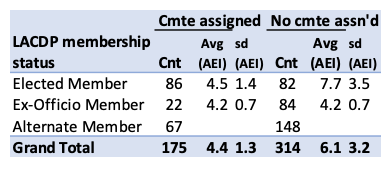CommentsPOLITICAL SHENANIGANS-In California’s primary held in March 2020, Angelenos voted for delegates to our County “Central” political “Committee.”
Out of a total field of 309 candidates, Democrats selected seven individuals per assembly district whose role would be to represent us, the electorate. We have a reasonable expectation to be represented faithfully by these representatives, selected politically in a democratic, electoral process.
But political parties are only quasi-governmental. They “play one on TV” but are in fact owned and operated as a private club. The political party used for endorsing and ultimately selecting our public, government officials, is itself not mandated by sunshine laws or public sector requirements, but by its own private bylaws. The expectation of representation, at least in terms of 1 person:1 vote, is simplistic.
In the case of LA County’s (LAC) Central Democratic Committee, the LACDP, there are 24 constituent state assembly districts (ADs), the geographic boundary that defines CA state Assembly member’s territory; find yours here. In 22 of these ADs, the LAC registrar conducted contested elections this past Spring. For the two without elections, delegates were appointed to seat vacancies by the Democratic Party (DP) chair for a total of 168 “elected” members of the LACDP (table 1).

Table 1. Distribution of delegates to the LAC Central Committee (LACDP, 8/20) by membership status. Elected delegates to the LACDP constitute one-third the overall membership and comprise ~60% of eligible full-assembly voters.
The precise rules for party membership, participation and voting are complicated, found in LACDP’s bylaws here. The state party, CADEMS, produced an excellent series of explanatory videos here.
But the full denominator of membership may never be fixed as associate members come and go, and chair-appointments are hard to reckon. Currently, the full LACDP is well over 500 strong, including members elected to state- and county-wide offices (“ex-officio” members) who vote in the general assembly of the Central Committee; non-voting members associated, for example, with Democratic clubs; and alternates for most of these members who vote in the general assembly only in the absence of the representative for whom they are an alternate. Consequently, the relative proportion of voting members in the general assembly must remain approximate.
Committee membership is also labile but appointment and full voting privilege there is not tied to the elected or ex-officio member. Alternates are appointed to committee in their own right. They serve at the pleasure of the LACDP chair, as full voting committee members.
Therefore, total elected representatives to the root “County Central Committee” of the national DP’s pyramidal structure, constitute at most under one-third of the local membership. And while the proportion of elected representatives may hover around 60% of any given full assembly meeting’s voting delegates (168/N(elected, Ex-officios) = 274), the work of a large organization is accomplished in committee. And just under half the elected delegates (first row, table 2) have been excluded from any committee assignment whatsoever . . .even while nearly 30% of those assigned to committees (51 of 175 unique individuals) serve on more than one (table 3). When we vote for representation on the local DP, we summon but a faint fraction of it.

Table 2. Only half the elected LACDP members are assigned to serve on a committee.

Table 3. Every committee has individuals serving on more than one committee. Nearly one-quarter of all seats are occupied by members serving on more than one committee while nearly 30% of all elected members are without a committee assignment.
There is a bias in assignment of committee work that favors longevity in the party (familiarity) and affirmation of incumbency (conformity).
Immediately upon swearing in this term’s members, leaders were elected from within each assembly district membership. Without LACDP disclosure of alternates and ex-officio members, the electorate was unknown and unknowable. Incumbents were familiar with one another; newcomers do not know who is involved or the scope of the delegation which whom they are unfamiliar. Campaigning, then, is a function not of ideas or persuasion but of who can be reached: a function of prior familiarity.
It took a spontaneous resolution during the full party’s first “organizational” meeting to compel the LACDP to distribute a simple list of the electorate to officer candidates. But it is not only the passive control of information and prior familiarity that constrains LACDP elections of party leadership. As it happens individual’s personal choice regarding party leadership is not private. In stark contrast with LACDP which holds its group-organizational prerogative fiercely secret, individual’s policy-selections are publicly disclosed. Conducted in advance of committee assignments, the association between voting to favor incumbency and committee membership, suggests either passive or active bias in subsequent committee assignment. For one reason or another, committees are composed of members who do not challenge the party line (table 4).
Among four officer elections a score of 1 is ascribed each vote for an incumbent, 3 for a challenger and 2 for an abstention. This simple “AEI” index ranges from 4 to 12 and reflects favor of party-line incumbency vs alternative leadership.

Table 4. Proclivity for alternative leadership is clearly different among elected and ex-officio members, as well as between those assigned to committee and not. The difference according to those with and without any committee assignment is found only among elected members.
The association of leadership preference with assignment to any committee is not attributable to a proclivity for incumbency alone. Cause and effect are not clear, but at the least a difference in tolerance for incumbency among membership types is significant. Ex-officios are different from elected members in ways likely to be reflected in committee voting. Committees composed of varying membership-types (table 5) do reflect some slight variation in their membership’s preference for leadership, but none even close to the average among elected members excluded from committee membership (“AEI” = 7.7 ± 3.5 vs 4.5 ± 1.4).

Table 5. Membership composition of the LACDP’s 16 committees, and the proclivity of committee’s members to favor leadership incumbency.
Having long heard of party shenanigans, it is another matter altogether to witness the microcosm of its sausage in the making. The opportunity to be a constituent part of the Democratic Party -- as is the prerogative of members elected by a believing public in order to be representative of their interests -- is curtailed by our very own baby-, local-version of shenanigans. Representatives of the LACDP unwilling to vote indiscriminately for LACDP incumbents are at least initially excluded from meaningful participation, ensuring robust continuation of Party status quo.
This bias of longevity and familiarity might be understood to favor experience and institutional memory. Across all ADs the average number of votes received in the March primary among members assigned a committee is larger than among those who were not (table 6). Candidates not elected outright often are instead appointed by an elected member as their alternate, thus manifesting a popular vote count even when technically “not-elected.” Popularity might be high for a variety of reasons, e.g. as a function of incumbency and, also, as a function of electorate excitement for an alternative candidate. The difference is trivial among alternates in vote count between those assigned committees and not. On average, that is.

Table 6. Average vote total from the primaries by member-type across all ADs. Popularity is higher among elected members than alternate members. But among alternate members between committee assignments, the difference is not meaningful. Among elected members on average the vote count is higher for those assigned to committee.
But in specific districts popularity is systematically inversely proportional to popular vote as well as association with leadership conformity (table 7). The singular elected member there assigned to committee has less votes than the average of the remainder, unassigned electeds; all the assigned alternates have lower totals than the unassigned alternates. And among the unassigned elected members, the index tracking tolerance for leadership challenge is striking. A conclusion of retribution attached to committee assignment is hard to avoid. At least in some ADs.

Table 7. Committee membership can be biased among popular vote and leadership preference within specific ADs. AD51 exhibits systematic underrepresentation of elected members with high popularity and significant departure from conformity in leadership preference.
It is frustrating to be elected to a central political committee and be blocked from involvement before the session ever begins. It is frustrating to publicly demand electoral reform, to witness the horror of elections tampering over decades by the opposition and daily from the current federal executive regime. . .only to then witness a mirror image of finagling within the lowest rung of my own political party.
Does any of this matter? Most assuredly – this is where an organization grows its continuity and absorbs the new flavors of an evolving electorate. Without feedback from new sensibilities there is no way to update relevance and stay useful, representative. To systematically oppose the new or different is to fetishize the status quo and enable otherwise-ordinary degeneration.
These political parties, it turns out, are the original Public-Private Partnership. As private organizations they attach themselves to the body politic and extract its public resources for private gain. When representativeness is thwarted for private purposes, whether of an individual or a party for its own sake, the individual-as-citizen (you and me) is disenfranchised. This matters.
If you would like to see popular opinion represented upstream across the national stage, then look to the doings at a local level and hold the officials there accountable. If you elected someone to represent you in the local political party, then make sure you stay aware of whether that wish of yours is respected. This first month witnessing the shenanigans of our local LACDP has been a shock almost as dispiriting as watching the Kabuki from D.C.
(Sara Roos is a politically active resident of Mar Vista, a biostatistician, the parent of two teenaged LAUSD students and a CityWatch contributor, who blogs at redqueeninla.com). Prepped for CityWatch by Linda Abrams.















